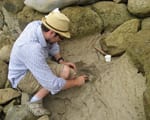256-million-year-old Niassodon mfumukasi is the first new genus and species of a fossil vertebrate from Mozambique, and its species is a distant relative of living mammals
A new species and genus of fossil vertebrate has been identified from the remote province of Niassa in Mozambique, according to an international team of paleontologists.
The species is a distant relative of living mammals and is approximately 256 million years old, the researchers reported Dec. 4 in the scientific journal PLoS ONE.
The new species belongs to a group of animals called synapsids. Synapsida includes a number of extinct lineages that dominated land communities during the Late Permian from 260 million years ago to 252 million years ago. Synapsida also includes some living mammals and their direct ancestors, including humans.
Rare example is a fossil first for Mozambique
Niassodon mfumukasi is the first new genus and species of a fossil vertebrate from Mozambique. Its name-bearing specimen, called a holotype, is a rare example of a basal synapsid that preserves the skull and much of the skeleton together, the scientists reported.

“Mozambique is an unexplored country paleontologically,” said Ricardo Araújo, a paleontologist at Southern Methodist University, Dallas, and a member of the scientific team.
“The patterns that have been observed in sedimentary basins of the surrounding African countries of similar age show high levels of species unique to the basin, thus restricted geographically,” said Araújo.
It was interesting to observe the same pattern repeating in Mozambique, Araújo said, especially with such a pristinely preserved specimen.
“This specimen was so well-preserved that we even observed the complete anatomy of certain skull bones that have never been observed, despite more than 150 years of research in this group of animals: the dicynodonts,” he said.
International team of paleontologists named new fossil as a tribute to Mozambique
The fossil was named Niassodon mfumukasi, which in the local Chiyao language means “the queen of Lake Niassa.” The name is a tribute to the Yao matriarchal society, to the women of Mozambique and to the beauty of Lake Niassa.
A team of paleontologists from nine institutions in Mozambique, Portugal, the United States and Germany described the anatomy of Niassodon in “Bringing dicynodonts back to life: paleobiology and anatomy of a new emydopoid genus from the Upper Permian of Mozambique,” in PLoS ONE.
Leading the research were: SMU’s Araújo in the Roy M. Huffington Department of Earth Sciences and Portugal’s Museu da Lourinhã, Rui Castanhinha Instituto Gulbenkian de Ciência and Museu da Lourinhã, and Luís Costa Junior, National Museum of Geology in Maputo, under the auspices of Projecto PalNiassa.
Projecto PalNiassa is an international, multidisciplinary scientific collaboration that includes more than two-dozen scientists from three different continents. The goal of the project is to find, study and preserve the paleontological heritage of Mozambique.
3D tomography reconstructed fossil’s bones and built virtual model of brain
By using micro-computed tomography it was possible to reconstruct digitally not only the bones of Niassodon but also to build a virtual model of its brain. This reveals new information on the brain anatomy of early synapsids, which is important for understanding the evolution of many features of the mammalian brain.
The reconstruction of the brain and inner ear anatomy developed for Niassodon is the most detailed presented to date for an early synapsid. Using the digital data acquired in the tomographies it was possible to isolate all individual bones preserved, which allowed the researchers to create a new topological color code, codified mathematically, for the cranial bones. This code will allow the researchers to standardize the colors used in similar digital models built for other animals.
The fossil can be visited in Portugal’s Lourinhã Museum, but will return soon to the collection of the National Museum of Geology in Maputo, Mozambique.
The specimen was collected during fieldwork in 2009 with the support of National Museum of Geology, and was prepared at Portugal’s National Museum of Geology, the Instituto Gulbenkian de Ciência, Oeiras, Portugal, and at SMU.
The 3D tomography was performed at German Electron Synchrotron-Helmholtz Association of German Research Centers, Hamburg, Germany. The project was sponsored by Fundação Calouste Gulbenkian, National Geographic Society and TAP Portugal.


 To book a live or taped interview with Ricardo Araújo in the SMU
To book a live or taped interview with Ricardo Araújo in the SMU  Study: High-volume Bitcoin exchanges less likely to fail, but more likely to suffer breach
Study: High-volume Bitcoin exchanges less likely to fail, but more likely to suffer breach Musicians who learn a new melody demonstrate enhanced skill after a night’s sleep
Musicians who learn a new melody demonstrate enhanced skill after a night’s sleep Study finds that newlyweds who are satisfied with marriage are more likely to gain weight
Study finds that newlyweds who are satisfied with marriage are more likely to gain weight Fruit flies fed organic diets are healthier than flies fed nonorganic diets, study finds
Fruit flies fed organic diets are healthier than flies fed nonorganic diets, study finds